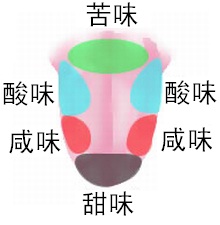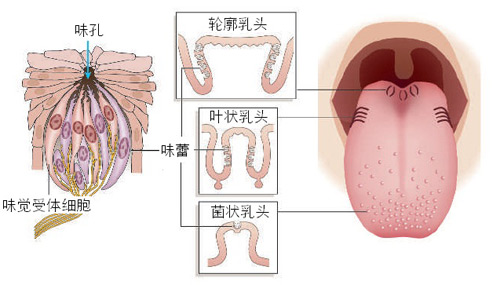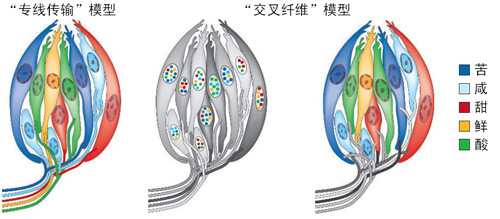Tasting knowledge of Fine Coffee
Rumor: the specific area of the tongue specializes in a sense of taste, the tip of the tongue is the most sensitive to sweetness, the root of the tongue is the most sensitive to bitterness, and both sides of the tongue are responsible for tasting sour and salty taste. This is what people often call "taste map".

A specious "taste map"
Truth: the idea of "taste map" has been around for decades. In fact, the cells that distinguish all kinds of taste exist in every taste bud, and the taste buds are distributed on the surface of the tongue and in the mouth, that is to say, the area with taste buds on the tongue can sensitively distinguish all taste senses. The rumored "taste map" actually does not exist. This textbook-level rumor actually comes from the scholars' false translation of the article.
In 1901, a German scientist published an article on the study of taste, describing the phenomenon that some people's tongues are more sensitive to a particular sense of taste, which is not a clear scientific conclusion. However, it makes people think that several areas on the tongue are only responsible for a specific sense of taste. Later, this fallacy was translated into English by Edwin G. Boring, a psychiatrist at Harvard University, and spread widely. After that, people have a gradually in-depth study of taste, and found that this is not the case. Let's review the conclusions of these studies before depicting the real "taste map".
The "three primary colors" of taste
In animals, the function of taste is to judge the nutritional value of food and avoid eating poisons. In human beings, taste has an additional meaning, that is, the pleasure of enjoying delicious food. After long-term research, people have found that mammalian tastes can recognize five basic tastes: sweet, fresh, bitter, sour and salty. Recently, there is also some evidence that animals recognize "fat". However, there is no consensus in academic circles on whether this fatty taste forms the sixth basic taste. Sweetness usually means that food is rich in energy, delicious taste represents food rich in protein (the taste of amino acids formed after protein decomposition), and salty taste enables people to eat the right amount of electric hydrolysate to maintain the balance of water and salt in the body. sour and bitter taste suggest toxic or potentially harmful chemicals.
A special structure on the tongue
Stick out your tongue in front of the mirror (it is recommended that when no one is there, dear), you will find that the surface of the tongue is rough, covered with many small protuberances, which are collectively called tongue nipples. The lingual nipple is divided into many kinds, the red round protuberances around the 1mm are called fungal nipples, which look like mushrooms under the microscope, hence the name; the lingual nipples near the tongue boundary groove at the end of the tongue are much larger than the fungiform nipples, and there is a ring around each protuberance (people who can't stick out the tongue can't see it themselves), they are called contour nipples. The fungal nipple and the contoured nipple are filled with conical filamentous nipples. There are many leafy nipples on the tongues of herbivores, and the phylloid nipples on the human tongue are almost degraded.
Taste is produced by taste receptor cells (taste-receptor cell, TRC). The taste receptor cells are concentrated in the taste buds, while the taste buds are mainly distributed in the nipples of the tongue, palate and throat mucosa. The top of the taste bud is the taste pore, which opens on the surface of the tongue. There are one to hundreds of taste buds in each nipple, and there are 50 to 150 taste receptor cells in each taste bud. The taste receptor cells recognize different taste stimuli and encode neuroelectrical signals. The taste information carried by these signals is transmitted to the cerebral cortex through special sensory nerves, and eventually becomes taste sensation.

Tongue nipple and taste buds
How do different flavors occur?
The conclusions about taste mainly come from the research based on experimental animals. Because taste is easily affected by other senses (such as smell, vision and touch, etc.), and experimental animals can not tell us exactly the taste of substances, it is difficult to obtain experimental results. Researchers usually use neuroelectrophysiological and behavioral methods to obtain the required conclusions.
Sweetness and bitterness are produced in similar ways. There is a signal protein called G-protein-coupled receptor on the surface of taste receptor cells, and sweetness and bitterness are produced by specific types of signal proteins.
Most mammals are strongly attracted by the taste of many L-amino acids, but humans can only taste monosodium glutamate (Monosodium glutamate, MSG, monosodium glutamate) and aspartic acid, which is the amino acid flavor, which humans call fresh. Freshness is also produced by specific G-protein-coupled receptors.
For salty and sour tastes, it is thought that these two flavors are related to the channels through which sodium and hydrogen ions enter the top of the cell, but whether there are special receptors for salty and sour taste is still controversial. It is generally believed that salty taste is mainly caused by the increase of sodium ion concentration in food, while the increase of hydrogen ion concentration in food produces sour taste.
The recent discovery of "fatty flavor" is now thought to be caused by fatty acid transporter CD36.
Signal coding of taste
When taste stimuli are felt by taste receptor cells, these stimuli are transmitted to nerve fibers, which transmit them over long distances. Nerve fibers can only transmit electrical signals, so a variety of complex external stimuli must first be encoded into potential signals that nerves can recognize and transmit before they can be transmitted to the brain to form sensation. How do taste receptor cells encode after they feel different taste stimuli?
How taste signals are encoded has been debated for a long time, and two models have been proposed: the "dedicated line transmission" model and the "cross fiber" model. In the dedicated line transmission model, the recipient cells respond to a single taste, and there are separate nerve fibers that transmit taste stimulation information, and there is no functional overlap between different cells or between different nerve fibers. In the cross fiber model, the same taste is transmitted into different cells or nerve fibers, that is, taste stimulation information is encoded before it reaches the nerve fiber, and a common circuit is used for signal transmission after entering the nerve fiber.

A model of taste coding. The "dedicated line transmission" model means that a taste receptor cell responds to only one taste and a single nerve fiber transmits taste stimulation signals (left); the "cross fiber" model means that the five basic taste signals are transmitted through common nerve fibers, such as those that do not specifically transmit sweetness. There are two more hypotheses in the cross fiber model: the middle picture shows that each taste receptor cell can recognize five basic flavors at the same time (there are five color dots in a cell at the same time). The picture on the right shows that each taste cell recognizes only one basic taste (one cell is a color).
Is it a taste receptor cell that can recognize a variety of different flavors, or a taste receptor cell that recognizes only one taste? The evidence obtained from molecular and functional studies in mice strongly supports the dedicated line transport model. In other words, each taste receptor cell recognizes only one basic taste, and a nerve fiber transmits only one taste signal.
But in any case, we can see from the above picture that one taste bud can identify five basic flavors at the same time, while adults have about 3000 taste buds scattered in the mouth, so the actual "taste map" should be like this.

The real "taste map"
Conclusion: the rumor is cracked. It turns out that taste buds are generalists, not legendary "professional workers". Licking lemons with the tip of your tongue can also sour you. The legendary "taste map" does not exist.
Update
After smashing the rumor of "taste map" on August 1, many netizens still find it unacceptable that "taste map" is a rumor. Some people think that different parts of the tongue are different in their sensitivity to taste, while others say that the tip of the tongue is indeed insensitive to bitterness. The bus understands this very well. After all, the sense of taste has certain subjective elements, and everyone has individual differences. Even if some people think that their epiglottis can taste bitter, it is not surprising that some people have done research and found that there are taste buds on epiglottis.
Under the influence of the term "taste map", people have always mistakenly thought that a tongue area is responsible for only one kind of taste. In 1974, the eldest sister Collings of the United States published an article explaining that she dripped different concentrations of sodium chloride (salty), sucrose (sweet), citric acid (sour), urea and quinine (all bitter) in different areas of the mouth of 15 volunteers to see the lowest concentration of chemicals that the volunteers could distinguish. Collings's experiments show that each tongue region can taste five flavors, but the sensitivity threshold is different. First of all, the value of the taste threshold (the lowest concentration of substances that can be tasted) is very small, which is quite different from the concentration of substances often encountered in life, and has no practical significance. The threshold difference of each district is also very small, and there is no practical significance. Secondly, the overlap range of the taste threshold of each tongue region is large, such as the sweet taste of sucrose, the taste threshold of the tip of the tongue and the back of the tongue is similar, for the salty taste of sodium chloride, the taste threshold of the tip of the tongue is similar to that of the front of the tongue. In addition, the taste threshold is different with different taste substances, such as bitterness, and the taste threshold of urea and quinine is quite different in different tongue regions. Finally, there are individual differences between people, for example, about 8.22% of the population can not taste the bitterness of phenylthiourea. In addition, different from the results of German Hanig in 1901, Collings compared the taste threshold obtained by the experiment and found that the tip of the tongue was the most sensitive to salt, the soft palate was the most sensitive to bitterness, and on the tongue, the root of the tongue was less sensitive to bitterness than the tip of the tongue. (Virginia B.Collings. Human taste response as a function of locus of stimulation on the tongue and soft palate. Perception & Psychophysics, 1974, Vol.16, No.1, 169174.
Of course, later studies have directly denied that there are differences in the taste threshold of sweet, salty and bitter taste in different regions of the tongue. Such as this article: Kaoru Sato, et al. Sensitivity of Three Loci on the Tongue and Soft Palate to Four Basic Tastes in Smokers and Non-smokers. Acta Oto-laryngologica. , 2002, Vol.122, No.4: Pages 74-82.
By studying the mechanism of taste production, we now basically agree that every region of the tongue can taste five basic tastes. Whether there is a difference in the sensitivity of different areas of the tongue can not be categorically denied, but from the relevant research conclusions, the difference is very small, and it does not have a big impact on the real life of ordinary people. To be sure, the previous statement about "taste map" is wrong.
Important Notice :
前街咖啡 FrontStreet Coffee has moved to new addredd:
FrontStreet Coffee Address: 315,Donghua East Road,GuangZhou
Tel:020 38364473
- Prev

Knowledge of coffee making utensils how much do you know about powder presses
I believe that every barista wants to have his or her own Tamper (or pressing powder hammer), because with each cup of espresso, the coffee maker uses a powder hammer to flatten the ground coffee powder, thus increasing the extraction quality of the coffee (although there are individual ways of not pressing the powder). So what's the use of the powder hammer? Why can it be so expensive? Why is there?
- Next

Why Africans Don't Drink Coffee
One of the things I was curious about was that coffee originated in Africa, but in many parts of Africa, especially in small towns and villages, very few people drink coffee. But a trip to Uganda, home of coffee, basically answers the question. In Uganda, near the Kenyan border, the village of Budadiri in Mombali is home to coffee farmers.
Related
- Beginners will see the "Coffee pull flower" guide!
- What is the difference between ice blog purified milk and ordinary milk coffee?
- Why is the Philippines the largest producer of crops in Liberia?
- For coffee extraction, should the fine powder be retained?
- How does extracted espresso fill pressed powder? How much strength does it take to press the powder?
- How to make jasmine cold extract coffee? Is the jasmine + latte good?
- Will this little toy really make the coffee taste better? How does Lily Drip affect coffee extraction?
- Will the action of slapping the filter cup also affect coffee extraction?
- What's the difference between powder-to-water ratio and powder-to-liquid ratio?
- What is the Ethiopian local species? What does it have to do with Heirloom native species?

